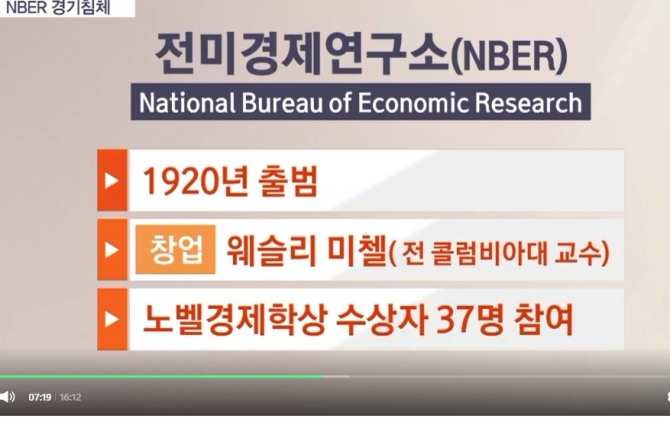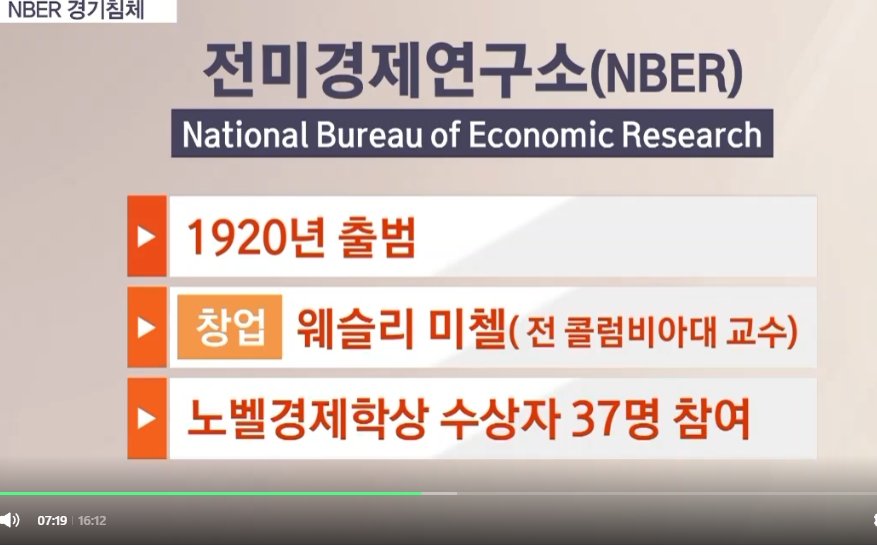시카고학파 원조 웨슬리 미첼 주도적 설립 , 선택의 자유 밀턴 프리드먼의 스승
 이미지 확대보기
이미지 확대보기인터넷 참여형 온라인 백과사전인 ‘위키피디아’에서 ‘경기 침체(Recession)’ 편집 전쟁이 벌어지고 있다. 미국의 2분기 경제성장률이 1분기에 이어 뒷걸음질치자 이를 경기 침체로 볼 지, 말지를 놓고 설전이 벌어지고 있다. 일부 사용자들이 ‘경제학자들은 일반적으로 2개 분기 연속으로 국내총생산(GDP)이 감소하면 경기 침체로 간주한다’는 내용을 추가하려는 시도를 했다. 여기에 대해 기존의 편집자들이 “근거나 인용이 부족하다”며 삭제했다. 미국 정부가 “공식적인 경기 침체 여부는 전미경제연구소(NBER)가 판단한다”며 GDP에 근거한 경기 침체를 부인하고 있다는 것이다. 치열한 공방이 계속 이어지다가 지금은 어정쩡한 휴전상태이다. 위키피디아는 ‘경기 침체’ 항목에 대해서는 자물쇠를 걸렸다. 신규 이용자의 편집을 막은 것이다. 위키피디아는 누구든 ‘편집’ 버튼을 사용해 적절한 근거와 인용을 통해 해당 항목에 대한 정의나 설명을 덧붙일 수 있다. 지금은 논란이 큰 만큼 일단 차단을 한 것이다. 경기 침체 논쟁이 너무 뜨겁다 보니 일부 사람들이 위키의 정의를 계속 바꾸려고 했고, 결국 편집 중단으로 이어졌다.
미국에서 경기침체를 공식으로 판정하는 곳은 전미경제연구처로 불리는 NBER이다. 경기상황에 대해 누구든 왈가왈부 할 수는 있지만 경제학계에서는 NBER의 판단만을 인정하고 있다. NBER 내 8명의 저명 경제학자로 구성된 ‘경기순환판단위원회’가 통상 만장일치로 경기 침체 여부를 판단한다. 이 위원회는 급여 수준, 소매 판매, 산업 생산 등 지표를 종합해 진단을 내리고 있다. 어떤 지표가 어느 정도의 가중치를 갖는지 고정된 공식은 없다. 회의 내용도 비공개다. NBER이 논의를 거쳐 경기 침체를 선언하기까지는 최소 수개월이 걸린다. 역대 경기침체 판정에 걸린 평균 기간은 약 7개월이었다. NBER은 경기 침체라고 판단할 증거들이 압도적으로 많이 모일 때까지 최대한 기다린다. 정확성을 기하자는 취지이다. NBER은 2020년 2월과 4월에 미국 역사상 가장 짧은 경기 침체가 있었다고 1년 이상 지난 2021년 7월 19일에 선언했다. 이 위원회는 정치적 외풍을 차단한 채 오로지 경제 현상만을 본다. 지금은 NBER이 경기를 판단하기 어려운 상황이다. 통상 경기가 안 좋아지면 고용과 소비, 다른 경제 활동이 함께 둔화한다. 지금은 2분기 연속 역성장을 하면서도 고용 시장은 미국 역사상 가장 좋은 상태를 보이는 특이한 상황이 연출되고 있다. NBER 경기순환결정위원장인 밥 홀 스탠퍼드대 교수는 월스트리트저널(WSJ)과의 인터뷰에서 “어느 한 지표를 다른 지표보다 우위에 두고 검토하는 경우는 없다”며 “GDP 수치만으로 침체 여부를 결정하지 않는다”고 말했다.
미국의 경기 침체 논쟁은 7월28일 발표된 미국의 2분기 경제성장률이 마이너스 0.9%로 나타나면서 뜨거워졌다. 1분기 마이너스 1.6%에 이어 2개 분기 연속 뒷걸음질했다. 경기 침체를 주장하는 측은 2개 분기 연속 감소한 GDP 증가율에 무게를 둔다. 역대 NBER의 경기침체판정을 보면 경제가 2개 분기 연속 역성장하고도 침체에 빠지지 않은 기록상 유일한 시기는 1947년뿐이다. 2분기에는 미국의 소비지표도 나빠졌다. 2분기 개인소비는 1.0% 늘어나는 데 그치며 코로나19 사태 이후 가장 부진한 모습이다.
경기 침체 논쟁은 미국의 올 가을 중간선거를 앞두고 정치적 이슈로까지 번지는 모양새다. 유례없는 인플레이션 즉 물가 상승으로 안 그래도 인기가 없는 바이든 대통령에게 경기 침체는 결정타가 될 수 있다. 공화당은 “바이든 정부가 침체를 피하기 위해 경기 침체를 재정의하려고 한다”면서 바이든 정부를 맹비난 하고 있다. 2분기 연속 역성장을 경기 침체라고 부르는 것은 시중의 관행일 뿐이다. 주로 언론의 평론가들이 많이 사용하고 있다. 학문적으로는 검증되지 않았다.
경기침체를 판정하는 전미경제연구소(National Bureau of Economic Research, NBER)는 1920년에 설립된 미국의 비영리 민간 연구조직이다. 미국 경제에 대한 연구를 전문으로 하고 있다. 미국 매사추세츠주 케임브리지에 본거지를 두고 있으며, 캘리포니아주 팔로 알토, 뉴욕 시에 지사가 있다 미국인 출신 노벨 경제학상 수상자 대부분이 이 연구소와 관련된 사람들이다.
이 연구조직은 웨슬리 클레어 미첼(Wesley Clair Mitchell) 만들었다. 웨슬리 클레어 미첼은 1874 년 미국 일리노이 주 러쉬 빌에서 태어났다. Mitchell은 시카고 대학 에서 경제학을 공부했다. 그의 스승은 Thorstein Veblen 과 John Dewey등이다. 시카고경제학파의 뿌리를 내린 대부들이다. 미첼은 University of Chicago (1900–02), University of California (1902–12), Columbia University (1913–19; 1922–44), New School for Social Research , New York City 등에서 연구를 했다. 1920 년에 미국 경제 연구국 조직을 주도했다. 이후 1945 년까지 NBER의 연구 책임자로 있었다. 1 차 세계 대전 중에는 전쟁 산업위원회의 가격 부문 책임자 그리고 후버 ( Herbert Hoover) 대통령 시절에는 사회 동향 연구위원회 위원장을 역임했다. 국가 계획위원회 (1933) 및 국가 자원위원회 (1934–35) 위원으로 활동했다. 경제 행동에 대한 정량적 연구 개발에 가장 큰 영향을 미쳤다. 저술에는 Business Cycles (1913), Business Cycles : The Problem and Its Setting (1927), The Backward Art of Spending Money (1937) 및 Measure Business Cycles (1946)등이 있다. 시카고학파로 널리 알려진 밀턴 프리드먼이 웨슬리미첼의 제자이다.
다음은 NBER 역사
Wesley_Clair_Mitchell with caption
At the outset, the NBER received essential support from the Carnegie Foundation and the Laura Spellman Rockefeller Foundation, and funding from several corporations. The founders recruited Columbia Professor Wesley Clair Mitchell, a leading expert on economic fluctuations, to serve as the inaugural director of research. He oversaw the organization’s research program for 25 years.
Business Cycles and National Income Accounting
Mitchell assembled a small group of researchers who were dedicated to improving economic measurement. Their research project measured labor’s share of national income. The team developed two distinct methods of estimating the labor share, and only when the estimates agreed reasonably well did they publish their findings. The careful attention to data quality and statistical methods in the study of the income distribution were widely recognized and the findings were well received. The inaugural project was followed by research on unemployment and, later in the 1920s, on business-cycle fluctuations. The NBER research staff published 23 books during the organization’s first decade. Years later, Solomon Fabricant, a former NBER vice president for research, summarized this formative period for the NBER in a short essay.
In 1927, the same year in which he published his classic book Business Cycles: The Problem and Its Setting, Mitchell recruited one of his recently graduated doctoral students, Simon Kuznets, to join the NBER staff. Kuznets quickly became an expert on economic measurement. In the early 1930s, in response to a request from the US Department of Commerce for support in developing measures of aggregate economic activity, he led an NBER research project that became the foundation of the US national income accounts. This was one of the contributions for which Kuznets would be awarded the Nobel Prize in Economic Sciences in 1971.
In 1936, Kuznets launched the Conference on Research on Income and Wealth, a group of researchers and economic statisticians devoted to improving measurement. The rapporteur for the first meeting was Milton Friedman, one of Kuznets’ students and a research assistant at the NBER. Friedman, who was honored with a Nobel prize in 1976 for his work on consumption and monetary theory, was an active contributor to the NBER’s research program for several decades.
Post-War Expansion of Research Scope
Mitchell set the research agenda for the NBER’s first quarter-century. In 1945, he and his student Arthur Burns published Measuring Business Cycles, summarizing important features of the NBER’s research on economic fluctuations. While celebrated for its data synthesis, the volume was sometimes criticized for its lack of a theoretical framework. Burns succeeded Mitchell as research director and served in this capacity until 1953, when he stepped down to chair President Dwight D. Eisenhower’s Council of Economic Advisers. Fabricant, an expert on productivity and business cycles, was appointed director of research in 1953, and served in this role for more than a decade.
Anna Schwartz
During the 1950s and 1960s, the NBER retained its focus on economic fluctuations, productivity and economic growth, and data creation, but the scope of research expanded. Milton Friedman and Anna Schwartz carried out path-breaking work on the impact of monetary policy on business cycles, a project that culminated in their landmark 1965 study, A Monetary History of the United States. Future Nobel Laureate George Stigler studied mark-ups and firm pricing behavior. Research in labor economics flourished, led by Jacob Mincer of Columbia with the active participation by future Nobel laureate Gary Becker. Becker’s classic treatise Human Capital was published by the NBER in 1962.
When Burns returned from Washington in 1956, he became president of the NBER. While previous presidents had served short terms, Burns served until 1967, when the NBER Board of Directors appointed John R. Meyer, a professor at Harvard University who was a leader in transportation economics and economic history, to the role of president. His arrival marked an important break with tradition: he was not an expert on business cycles and his research was focused on topics in micro- rather than macro-economics. Meyer launched a number of important initiatives as well as two NBER journals, Annals of Economic and Social Measurement and Explorations in Economic Research. He opened NBER offices in Cambridge, New Haven, Palo Alto, and Washington. The NBER devoted substantial resources to collecting and maintaining a database of macroeconomic time series and to creating the statistical software that could be used to access and analyze it. A long-lasting initiative, led by vice president for research Victor Fuchs, was a program of research on health economics, law and economics, demography, and social institutions.
Martin Feldstein Reinvents the NBER
Martin Feldstein with caption
Meyer was succeeded as president in 1977 by Martin S. Feldstein, who like Meyer was a professor at Harvard. Feldstein had recently received the American Economic Association’s John Bates Clark Medal as the outstanding economist under 40. His research focused on health care, taxation, and labor markets, but his wide-ranging interests expanded the scope of NBER activities. With the exception of the 1982-84 period, when he chaired President Ronald Reagan’s Council of Economic Advisers and MIT Professor Eli Shapiro served as NBER president, Feldstein led the NBER until 2008.
Feldstein was a transformative leader who re-invented the NBER. The organization had a staff of about 30 researchers in 1977, but he realized that it could play a much greater role in the economics profession as a network of university-based affiliates. By the early 1980s, there were more than 100 Research Associates, more geographically dispersed than the historical focus on New York, and by the time Feldstein stepped down, there were nearly 1,000.
Feldstein altered nearly every aspect of the NBER. He moved the headquarters from New York City to Cambridge, retaining a small office in Manhattan and closing offices in New Haven and Washington. He advanced the NBER’s role in disseminating economic research by developing the NBER Working Paper Series as a leading source of pre-publication findings and shuttered the NBER’s journals. The working paper series had been launched in 1973, and there were 142 such papers when Feldstein started. By the close of his term, there were more than 14,000. Feldstein appointed a formal Business Cycle Dating Committee, chaired by Robert Hall, to track turning points in economic activity and carry forward the NBER’s long-standing role in business cycle analysis. He also created research programs focusing on particular topic areas. In 1978, he launched five research programs: Economic Fluctuations and Growth, International Studies, Business Taxation and Finance, Financial Markets and Monetary Economics, and Labor Studies. Over time, other programs were added, and some of the initial programs were sub-divided.
Feldstein realized that the NBER could play a crucial convening function by bringing researchers with similar interests together. Each program held at least one meeting during each academic year. Another important milestone in 1978 was the launch of the NBER Summer Institute. That year’s meeting consisted of two small research conferences involving about 60 researchers. In recent years, the Cambridge-based Summer Institute has included more than 50 meetings and over 2,800 researchers.
Other important initiatives included the creation in 1986 of a research program on the economics of aging, led by David Wise, which ultimately established the NBER as a center for research activity in health economics and demography; the launch of the Macroeconomics Annual, initially directed by Stanley Fisher; the annual Tax Policy and the Economy conference in Washington, first organized by Lawrence Summers; and the International Seminar on Macroeconomics, under the direction of Robert Gordon and Georges deMenil. By 2008, when Feldstein became president emeritus, there were 19 research programs and a number of working groups studying a wide range of topics.
When Feldstein stepped down in 2008, MIT Professor James Poterba, a student of Feldstein’s as a Harvard undergraduate, was named NBER president. He continued the expansion of the NBER’s scope and span. The number of affiliated researchers, just over 1,000 in 2008, was more than 1,600 in 2021. A new program on Development Economics, launched in 2012, expanded the NBER’s research profile, and a working group on Market Design brought new ties to economic theory and computer science. Today, digital distribution has supplanted the distinctive yellow-paper-covered printed working papers, and the NBER distributes more than 1,200 new research studies each year. The NBER convenes roughly 125 meetings a year on a wide range of topics in applied economics.
김대호 글로벌이코노믹 연구소장 / 경제학 박사 tiger8280@g-enews.com


























![[이교관의 글로벌 워치] 독일과 일본이 각성할 때 한국은 무엇을...](https://nimage.g-enews.com/phpwas/restmb_setimgmake.php?w=80&h=60&m=1&simg=2025121311102201691f4f9a46d5b12456134167.jpg)
![[G-디펜스] 캐나다 해군 현대화의 숨은 열쇠 '디지털 훈련', 그리...](https://nimage.g-enews.com/phpwas/restmb_setimgmake.php?w=80&h=60&m=1&simg=2025121310301007854fbbec65dfb211211153121.jpg)
![[실리콘 디코드] 키옥시아 '3D D램' 핵심 기술 개발…고밀도·저...](https://nimage.g-enews.com/phpwas/restmb_setimgmake.php?w=80&h=60&m=1&simg=2025121309454509678fbbec65dfb121131206187.jpg)













